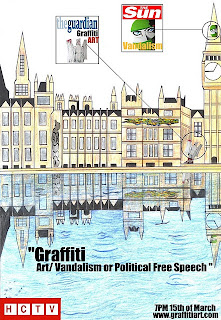1) In what ways does your media product use, develop or challenge forms and conventions of real media products?
There are so many documentaries out there made by different TV channels made by famous documentary production companies. It is hard to keep audience interest for nearly 30 to 45 minutes in a documentary. While making the documentary, a lot of attention is needed to engage audience. There is a danger of falling in common territory. While bearing all this, we found that the article and news in Art and Entertainment page covering the topic on "Graffiti" in public newspaper. Before finalising our topic, we had discussed about other topics but every one found this topic interesting and unique. Therefore, we decided to choose a topic for our documentary "Graffiti Art/ Vandalism or Political Free Speech".
To have a clear understanding about the documentaries, we thoroughly researched and analysed different documentaries created by BBC, Channel 4, ITV etc. Our media product used different forms and convection of media products like cut-aways, voice over, rule of third etc.
As Graffiti is a very controversial subject, we decided to capture opinions of different people from different lives; from graffiti artist to general public and students. Some sees graffiti as vandalism but is it really a vandalism? Some sees it as an Art but is it really an Art? or Is it a Political Free Speech? We will come up with tens and thousands of different answers. Whether it is criticism or complement, people are free to label it. So, here in our documentary we had tried to show the point of different people.
In our Pre-production stage, I watched many graffiti documentary both 'against and for'. The short documentaries, "Street Art" and "The Birth of Israel" helped me to understand more about framing interviewee and capturing location in the documentary . These documentaries consisted of different topic and contents: one is Graffiti Art and another is of history of Israel. The subject of documentaries have a huge contrast. Their difference helped me a lot about how to framing an interview with soundtracks attached on it. The figure1 and figure2, given below show the importance of capturing interviewee's complete facial detail and camera should be located in such a way that it must avoid interviewee looking direct at the camera but rather on left or right side.
Figure:1 |
Figure:2 |
While putting these framing in mind, we tried to capture the interview in a same way for our documentary. Here , while filming, we used medium Shot a lot. This shot is usually used to show the facial expression of the character. As we are making a documentary, we used this shot to focus on interviewee.
Figure:3 |
In the documentary, we added different pictures of graffiti as it will divert our audience's interest for a while. As our documentary is about Graffiti/ Art, so the pictures of graffiti in the documentary is common to be seen in the clip. Even while interviewing graffiti artist (figure:4), we interviewed him in the place where the graffiti cab be seen. Therefore, connotes him as graffiti artist. For most of our interviews, we used blue colour wall at the background because it helped to isolate the interviewee with it's surrounding.
 |
| Figure:4 |
For some of the basic clips, we put some cut- a- ways of the actual graffiti artist spraying the wall in Waterloo. As we are making a documentary about graffiti, it is quite basic to use this kind of clip. Audience expect these kind of clip in our documentary. While filming him, we had used long medium shot because we wanted to focus more on the body of graffiti artist, his body posture while making a graffiti and to show what he is making.
 |
| Figure:5 |
In few scenes (figure:5), we have shown a clip along with the bit of information about graffiti in the side because it helps a lot to our audience to understand more about the graffiti and Law. As we had only written in important information about graffiti in the side of the clip it is quite easy for our audience to give more attentions to those words.
As a sound person it was hard for me to find the right music for our documentary. I went through over 10-20 CD's to get the right music for our documentary. While watching these documentary, I have even noticed that the music changes as the scene changes and music becomes dramatic when something is big about to happen or something exciting is about to happen. This has helped me a lot to choose appropriate soundtrack. As music plays a vital role in documentary I have tried my best to choose right music for it. I selected various music from different albums like Art Bust, think creative, Jazz, Punk and Hip-Hop etc.
Here, in our documentary, we used only one track because if we use many tracks in one video then it may get degaster and keeping that in mind we had only decided to use this one music. I actually got this music from the CD Album called Jazz Track 1. The reason why I chose this music among others are because it has every bit of thing that I need as a audio. From the music of DJ's kit to the music of drum,his music sound more like mix of jazz and R N B mix. For our voice over we asked Andy Popperwell as his voice sounds posh, strong an attractive at the same time.













